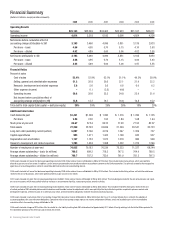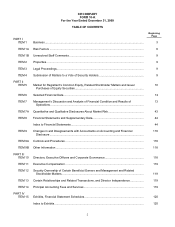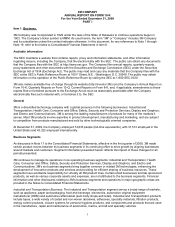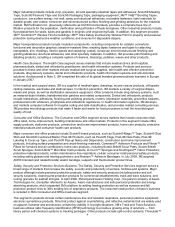3M 2009 Annual Report Download - page 14
Download and view the complete annual report
Please find page 14 of the 2009 3M annual report below. You can navigate through the pages in the report by either clicking on the pages listed below, or by using the keyword search tool below to find specific information within the annual report.
8
Item 1A. Risk Factors
Our disclosure and analysis in our Annual Report on Form 10-K contain forward-looking statements that relate to
future events and typically address the Company’s expected future business and financial performance based on
certain assumptions. These assumptions and expectations of future events and trends are subject to risks and
uncertainties. Depending on a variety of factors, actual future results and trends may differ materially from historical
results or those reflected in any such forward-looking statements. Provided below is a cautionary discussion of what
we believe to be the most significant risk factors applicable to the Company. Discussion of these factors is
incorporated by reference into and considered an integral part of Part II, Item 7, “Management’s Discussion and
Analysis of Financial Conditions and Results of Operations.”
* Results are impacted by the effects of, and changes in, worldwide economic and capital markets conditions. The
Company operates in more than 65 countries and derives approximately 63 percent of its revenues from outside the
United States. The Company’s business may be adversely affected by factors in the United States and other
countries that are beyond its control, such as disruptions in financial markets or downturns in economic activity in
specific countries or regions, or in the various industries in which the Company operates; social, political or labor
conditions in specific countries or regions; or adverse changes in the availability and cost of capital, interest rates, tax
rates, or regulations in the jurisdictions in which the Company operates.
* The Company’s credit ratings are important to 3M’s cost of capital. The major rating agencies routinely evaluate the
Company’s credit profile and have assigned debt ratings to 3M that are near the top of the ratings spectrum. This
evaluation is based on a number of factors, which include financial strength, business and financial risk, as well as
transparency with rating agencies and timeliness of financial reporting. The Company has an AA- credit rating, with a
stable outlook, from Standard & Poor’s and an Aa2 credit rating, with a stable outlook, from Moody’s Investors
Service. The Company’s strong ratings serve to lower 3M’s borrowing costs and facilitate access to a variety of
lenders. Failure to maintain the current ratings level could adversely affect the Company’s cost of funds, liquidity and
access to capital markets.
* The Company’s results are affected by competitive conditions and customer preferences. Demand for the
Company’s products, which impacts revenue and profit margins, is affected by (i) the development and timing of the
introduction of competitive products; (ii) the Company’s response to downward pricing to stay competitive;
(iii) changes in customer order patterns, such as changes in the levels of inventory maintained by customers and the
timing of customer purchases which may be affected by announced price changes, changes in the Company’s
incentive programs, or the customer’s ability to achieve incentive goals; and (iv) changes in customers’ preferences
for our products, including the success of products offered by our competitors, and changes in customer designs for
their products that can affect the demand for some of the Company’s products.
* Foreign currency exchange rates and fluctuations in those rates may affect the Company’s ability to realize
projected growth rates in its sales and earnings. Because the Company’s financial statements are denominated in
U.S. dollars and approximately 63 percent of the Company’s revenues are derived from outside the United States,
the Company’s results of operations and its ability to realize projected growth rates in sales and earnings could be
adversely affected if the U.S. dollar strengthens significantly against foreign currencies.
* The Company’s growth objectives are largely dependent on the timing and market acceptance of its new product
offerings, including its ability to continually renew its pipeline of new products and to bring those products to market.
This ability may be adversely affected by difficulties or delays in product development, such as the inability to identify
viable new products, obtain adequate intellectual property protection, or gain market acceptance of new products.
There are no guarantees that new products will prove to be commercially successful.
* The Company’s future results are subject to fluctuations in the costs and availability of purchased components,
compounds, raw materials and energy, including oil and natural gas and their derivatives, due to shortages,
increased demand, supply interruptions, currency exchange risks, natural disasters and other factors. The Company
depends on various components, compounds, raw materials, and energy (including oil and natural gas and their
derivatives) supplied by others for the manufacturing of its products. It is possible that any of its supplier relationships
could be interrupted due to natural and other disasters and other events, or be terminated in the future. Any
sustained interruption in the Company’s receipt of adequate supplies could have a material adverse effect on the
Company. In addition, while the Company has a process to minimize volatility in component and material pricing, no
assurance can be given that the Company will be able to successfully manage price fluctuations or that future price
fluctuations or shortages will not have a material adverse effect on the Company.
























